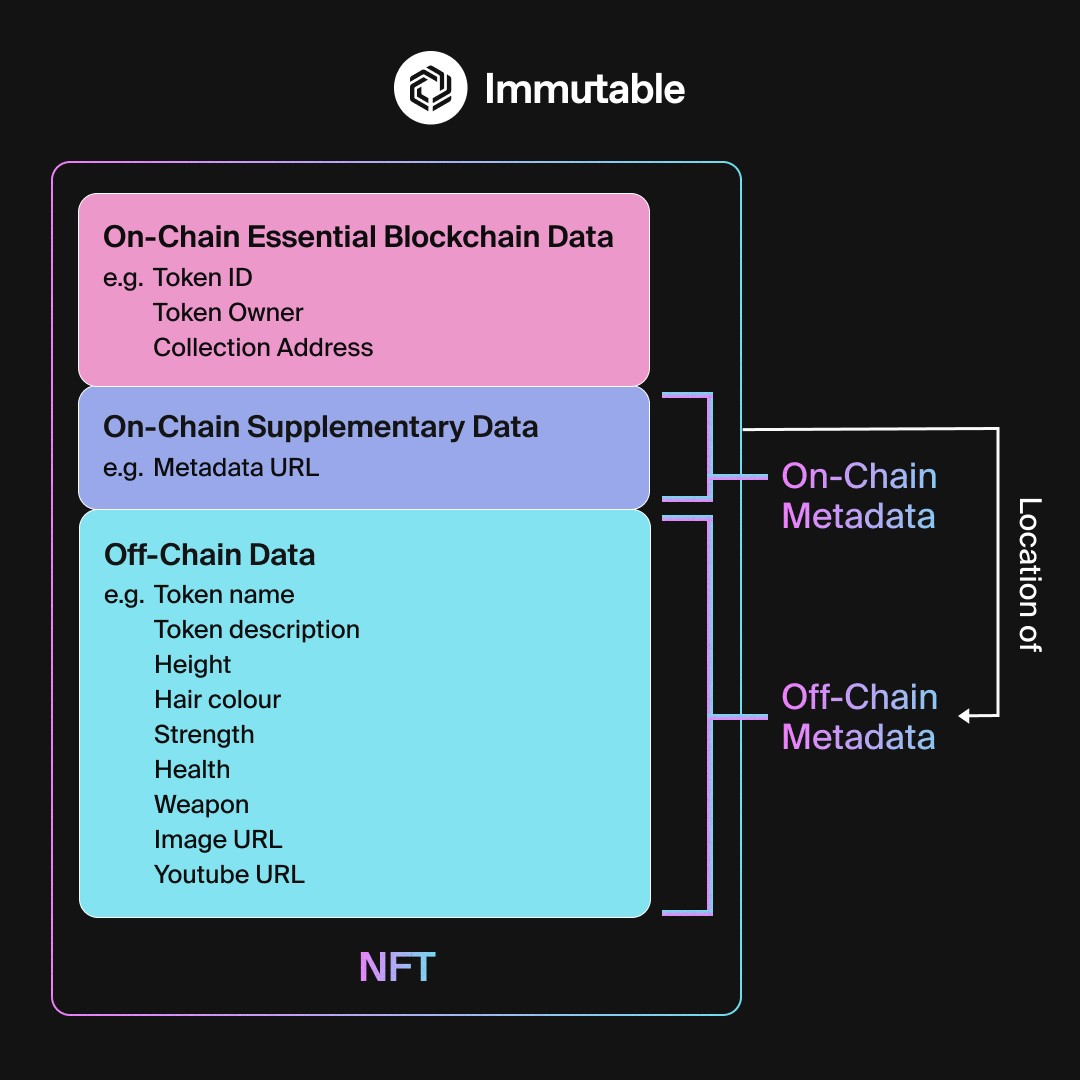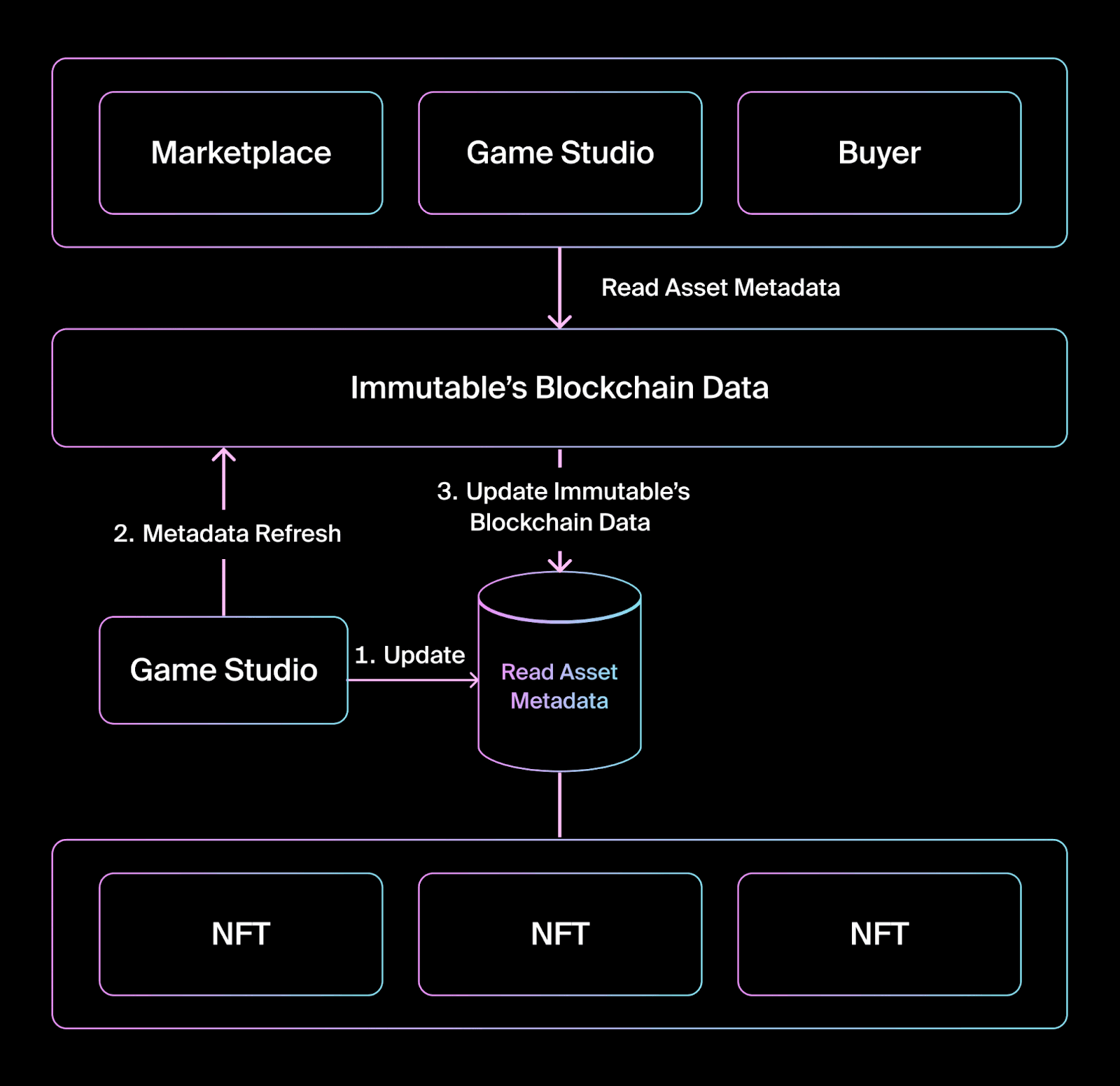Company News
Blockchain Gaming: What is Metadata and Why Does It Matter?
Aug 2, 2023



In this article we are going to explore how metadata plays a critical role in the Web3 gaming experience, using crafting as a case study. While the role of metadata in web3 gaming may not get as much attention as it deserves, it’s an essential component of every web3 game. Metadata is the secret sauce that enables the creation of unique, verifiable, and tradeable digital game assets, defines the scarcity, rarity, and utility of those assets, and facilitates asset customization to drive deeper community engagement.
Immutable recognizes the importance of metadata and aims to make it as frictionless as possible for game developers to update their in-game assets, improve the gameplay experience, and increase discoverability and liquidity of NFTs. Now, let's delve into how metadata is utilized in web3 game design to facilitate core activities and foster robust game economies.
What is metadata?
By now you probably know that a non-fungible token (NFT) is a digital asset that represents ownership of something unique within the blockchain world. In a smart contract (collection) that generates an NFT, there are important details that make the blockchain work, like a special ID that identifies the asset (called the Token ID) and the public address of the person who owns the asset (their wallet).
But these details are insufficient to understand what the asset is and why it has value. NFTs also include extra information that adds to their story and makes them even more special. This extra information, known as metadata, helps potential buyers understand the NFT's background and characteristics.
Metadata is defined as a collection of data that provides descriptions and information about other data entities. Within the context of web3 gaming, an asset's metadata determines its behavior within a game.
In essence, metadata is what makes NFTs interesting and valuable!
How does metadata impact the gaming experience?
Metadata plays a critical role in multiple aspects of the Web3 gaming experience. Here are some key activities where metadata plays a crucial role:
1. Gameplay: The attributes of an asset's metadata directly influence gameplay. For example, if there are two swords represented as NFTs, with one having metadata with double the attack power of the other, the game will respond differently depending on which sword a player wields. Metadata shapes the gameplay mechanics and adds depth to the gaming experience.
2. Trading: Metadata plays a pivotal role in defining the properties of web3 assets, setting them apart from other assets and influencing their overall value. On web3 gaming marketplaces, buyers often seek to purchase assets with specific metadata attributes. These attributes determine the amount buyers are willing to pay to own the asset.
3. NFT reveals: NFT reveals occur when a client owns an asset but is unaware of its specific details. This is akin to a player buying a pack of cards or receiving a reward without knowing the contents until an additional action occurs. The reveal process involves updating the asset's metadata so that its owner understands its functionality and value. This activity is very similar to crafting which we will explore in the next section.
4. Game rebalancing: After a game is launched, adjustments may be necessary to ensure that assets perform as intended by the game studio. If an asset is not meeting its intended functionality, modifying its metadata can rebalance the asset and the associated gameplay.
The significance of metadata in shaping and enriching the web3 gaming experience becomes evident through the aforementioned in-game activities. Now, let's embark on a deeper exploration of crafting to illustrate how metadata serves as a driving force behind every aspect of a game's crafting system. Additionally, we will delve into how a well-designed metadata architecture can empower games to create more resilient and thriving game economies.
A closer look: How metadata fuels web3 crafting
Crafting involves players combining in-game items or resources to create new and more valuable items or unlock unique content. Crafting is another system in web3 gaming that is intricately connected to an asset's metadata.
Metadata motivates players to engage with the crafting system in the following ways:
Requirements for crafting: Crafting recipes refer to specific combinations of assets that are required for the crafting process. An asset's existing metadata determines if the asset is eligible for crafting a specific recipe to achieve a desired outcome.
Desired outcome from crafting: Players engage in the crafting process to upgrade or change their assets to meet a desired in-game purpose or advantage. This could be combining items to craft a more powerful sword, or mixing ingredients together to create a new food item. This is achieved by changing an existing asset's metadata or creating a new asset with desirable metadata.
Higher status from crafting: Crafting can elevate the status of an asset without changing its in game behavior. Status represents social recognition and prestige within the web3 gaming community. Players who possess high-status items reflected in metadata often earn respect, admiration, and attention from others. For instance, in the multiplayer card game Gods Unchained, players can merge multiple copies of the same card to create a single card of higher status. Competing against an opponent who owns a deck full of higher status cards signifies a formidable challenge and denotes an elite player. It is the asset’s metadata that determines the status of the asset.
Furthermore the crafting process has direct influence over an asset’s metadata. Almost all crafting transactions occur in one of the following two ways:
Mint and Burn: This method involves creating a new asset with desirable metadata by collecting and "burning" (permanently removing from circulation) other assets involved in the crafting operation. This method is recommended if the crafting process creates new assets that are significantly different from the ingredients required by the recipe.
Metadata Updates: This method entails upgrading an existing asset’s metadata by collecting additional assets. This process may or may not involve burning on-chain assets depending on the resources needed to upgrade the asset. This method is recommended if the crafting process upgrades an asset, or if a game’s economy is very sensitive to gas fees.
Metadata drives the crafting process from a gameplay perspective, and it even has an important role to play in the mechanics that enable crafting. Each of the above crafting methods requires a different degree of on-chain activity, which incurs gas fees. Therefore, how a game studio architects their metadata and crafting processes affects their operating costs; impacting the game economies they are able to create. We will now look at how Immutable enables game studios to maximize their game economies through the architecture of its metadata.
How Immutable’s Platform Approaches Metadata
Immutable adopts metadata management strategies to provide the best web3 gaming experience, whilst reducing overhead costs. To do this, Immutable recommends that most NFT metadata is hosted off-chain, with the exception of the metadata repository location.

Immutable's Blockchain Data indexer is responsible for maintaining and tracking an asset's metadata. This allows for the refreshing of an asset's metadata that changes the most regularly due to gameplay mechanics as an off-chain event, without incurring additional gas fees. If an asset’s metadata is updated off-chain, calling Immutable’s Metadata Refresh function will update Immutable's Blockchain Data indexer. This enables various community members such as marketplaces, traders, or other game studios to have access to all assets within the Immutable’s ecosystem in a central, standardized location. This level of transparency contributes to a more informed and transparent ecosystem.

This provides the following benefits to game studios:
Reduced minting costs:
Storing metadata off-chain reduces the cost of minting for game studios, as less data is stored on the blockchain. For example, storing 1 GB of data on the Ethereum blockchain can cost a significant amount of Ether (ETH), with estimates suggesting around 17,500 ETH, equivalent to approximately $32.5 million USD as of June 2023 . This cost becomes more evident when considering the size of assets like full-feature length movies, with a typical 1080p movie ranging from 3 to 4 GB. Storing an entire Marvel Cinematic Universe (MCU) movie on the blockchain would incur a cost nearly equivalent to the movie's production budget, making it financially impractical.
This approach offers game studios and creators more flexibility in managing and updating information associated with their assets, without the need to modify the blockchain and incur gas fees. Storing metadata off-chain enables the inclusion of diverse and richer metadata, including larger file sizes, multimedia content, and interactive elements that may be impractical to store directly on the blockchain due to size and cost considerations.
Reduced crafting costs
Storing metadata off-chain reduces the amount of on-chain activity required when the Metadata Update crafting approach is adopted. The Metadata Update crafting approach is less gas intensive than minting new assets; and if no burn activities are required, it could even be done gas free. Through refreshing the Blockchain Data indexer after the crafting action, all participants in Immutable’s ecosystem are made aware of the upgrade, despite the majority of the activity occurring off-chain.
Immutable's metadata architecture, combined with its robust Blockchain Data indexer, provides game studios with the ability to design games that effectively reduce gas fees while maintaining optimal gameplay experiences. This empowers game developers to craft innovative systems for crafting and other in-game mechanics, ensuring minimal external expenses. As a result, game economies are strengthened, and the burden of additional fees is prevented from being passed on to players. This approach promotes a more sustainable and player-friendly environment within the gaming industry.
Conclusion
In the world of web3 gaming, assets play a central role in driving in-game mechanics and facilitating trading. The distinguishing factor that sets assets apart from one another is their metadata. By storing NFT metadata off-chain and streamlining the crafting process, Immutable provides game studios with the means to elevate the overall gameplay experience while minimizing expenses. The Blockchain Data indexer fosters an active and well-informed player community, as it enables game studios to deliver engaging and immersive gaming experiences.
Immutable's commitment to web3 gaming goes beyond metadata. Our suite of tools, including the Blockchain Data product, empowers game studios with the flexibility to enhance game mechanics, support sustainable game economies, and foster collaboration and transparency among all participants in the web3 gaming space.
In conclusion, Immutable's approach to web3 gaming, backed by their innovative tools, empowers game studios to create compelling experiences, establish vibrant economies, and promote a collaborative and transparent gaming ecosystem.
Note: Immutable always takes privacy seriously, and we know it is a critical part of building trust with our community. While understanding and implementing NFT metadata correctly is a key part of making successful Web3 games and empowering creators, it's important that builders and creators keep user privacy at the heart of what they do - it's a key tenet of Web3.
